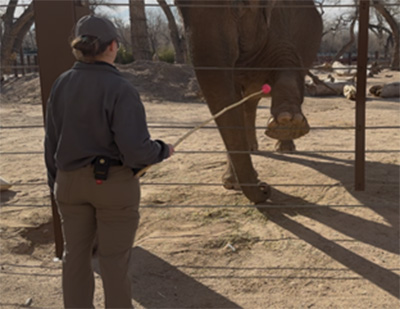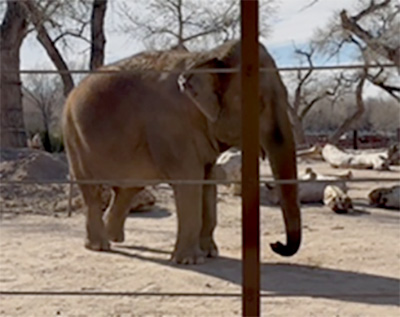Elephant – So Tired
Insomnia – It’s complicated
A big, older girl with a gentle soul was having a hard time sleeping. She laid down during the night but popped back up after a few minutes. She was also getting easily startled. There had been a lot of birthdays along the way, accompanied by a thick medical record. Everybody was worried. Her doctor contacted me for behavioral advice. No, not for herself – for her patient! Jeez.
Sleep happens in the brain but problems elsewhere in the body can have an impact. Veterinary behavior medicine includes all of it, so I offered to have a look. I’ve consulted for the ABQ Biopark in the past, on a jaguar, a capybara, and a spider monkey. This time it was “Irene” who needed help.
The matriarch of the Asian elephant herd is 58 years old and generally doing well for her age. She arrived in Albuquerque for a new life in 1997, following her stint performing in a traveling circus. It was a good move for Irene. Minus the leg chains, she has grown to really like people. She happily approached me to say hello when I sauntered up to her habitat. When Callie, her trainer, asked her for a variety of skills, Irene clearly enjoyed earning carrots for her work. She has a great life but she would feel a whole lot better if she could just lie down for a while and get a decent night’s rest.
We don’t have sleep studies on wild animals because, well, they’re wild animals. Luckily for elephants, we do have research on horses, a species with strikingly similar anatomy and brain function. Both often sleep while standing but they can only reach the deeper, physiologically essential REM (rapid eye movement) sleep while recumbent for at least a few hours.
In mid-January, guided by surveillance videos, the animal care staff noticed that Irene’s down time had dropped from 3-4 hours at a stretch to just several minutes. What happened? Take the quiz.
a) Disturbed by outdoor noises?
b) Uncomfortable bedding?
c) Pain?
d) Brain tumor?
e) Cranky?
A highly skilled, and tired elephant
Will Rogers once said, “I have always felt that the best doctor is the veterinarian. He can’t ask his patients what is the matter…he’s just got to know.” Old Will had a point. When I queried Irene, the Asian elephant, about why she wouldn’t lie down long enough to catch a few Zs, she wagged her trunk at me. Who knew elephants could be smart alecks? Clearly, we’d have to resort to modern medicine.
Dr. Carol Bradford, of the ABQ Biopark, had already x-rayed Irene’s feet and found them normal. She would have imaged other joints too if they weren’t too enormous for portable x-ray equipment. Physical exam findings and blood results were also fine.
I watched as Callie, the Biopark’s elephant trainer, put Irene through her paces. Every instruction was happily obeyed – except “lie down.” Doing her best to be a good pachyderm, Irene offered a different response instead, like raising one leg or backing up. She just couldn’t make herself roll over and play dead. We needed an expert, so I reached out for a third opinion.
Dr. Valarie Tynes is a board certified veterinary behaviorist in Sweetwater, TX. She helped guide my residency and, during a shared visit to the San Diego Zoo, began my education on her subspecialty – elephants. I wanted Dr. Tynes to have everything possible on Irene so I made careful notes of the big girl’s behavior, copied her sleep log, and shot several photos and videos. I sent it all off to this good doctor.
A physician once gave me advice I didn’t like hearing. He must have thought I was old. He told me, that as we age, we should expect aches and pains. Really? I already knew that about cats and dogs. Dr. Tynes explained that elephants are no different. She confirmed that joint pain was the likely culprit, making it too uncomfortable for our patient to down long enough for consistent REM sleep.
Which of these is most likely?
a) Disturbed by outdoor noises
b) Uncomfortable bedding
c) Pain
d) Brain tumor
e) Cranky
We focused our attention on c). We all agreed that Irene’s wellbeing was diminishing. It was time to act.
Aging isn’t for sissy elephants
There was more; Irene had accumulated a list of maladies during her 58 years. And, hey, which AARP member among us hasn’t?
The ABQ BioPark’s elephant herd includes Alice, born in 1974, and her daughter Rozie, a 1992 model. And, much as their natural ranging sisters would, they hang out together and get along fine. Albert, the stud with tusks, was born in 1998 to Calvin and Lilly at African Lion Safari in Ontario, Canada. Albert moved to the BioPark in 2003. Irene and Albert share a rather sordid history.
One fine day Irene ignited a fracas with this bull over attention from their care staff. She ended up on the ground, injuring her right front leg, which was already stiff. Her limp has improved somewhat since then but if you look carefully you can see a hitch in her get-along. She and Albert are now considered incompatible and haven’t shared space since 2020 but these highly social animals still need to see, hear, and smell each other. No longer picking fights, Irene now spends most of her time with Alice and Rozie.
I think that if elder elephants could speak a human language they’d agree that aging isn’t for sissies. Irene’s right eye developed a cataract 2 years ago. The lens dislocated, leading to inflammation and pain. Veterinary ophthalmologist Dr. Nancy McLean gave her the best medical treatment but without success. The eye was surgically removed.
Now sighted on only one side, Irene’s caretakers noticed her getting easily startled. Anxiety is common in aging elephants. Irene’s may have worsened with her chronic aching joints and partial blindness. Gradual hearing loss hasn’t helped.
When I arrived to meet Irene, the Biopark staff had already built a sand hill in her bedding area to make it easier for her to lie down and get up but colder January weather stymied that effort. We knew Irene’s quality of life was still good but we believed this lady, of a certain age, could feel much better.
Cheating age
The biggest reason Irene developed arthritis is because she’s reached her golden years. This would not have occurred in the wild. As she aged in that competitive environment, with pain and stiffness, partial blindness and diminished hearing, she would have lost her edge. There are no veterinarians in the tropical forests of Asia. Her 58th birthday would not have arrived without the Biopark’s excellent animal care staff. Because of them her good quality of life can extend into her 60s and maybe her 70s.
Dr. Bradford started Irene on a safe and effective antiinflammatory/pain reliever called meloxicam. Dr. Tynes advised a 4-6 week trial. In just 2 weeks Irene was getting around better and sleeping soundly at night for 3-4 hours at a stretch before getting up to, well, stretch and go back to bed. That’s normal for those of her ilk. The medication worked and we had the diagnosis.
As the weather gets warmer Irene’s joints may feel good enough to allow healthy sleep without medication. But as she adds more birthdays she may require year ‘round treatment. An equine preparation, called Gastro Guard, can be added to prevent possible stomach ulcers.
With less pain we’re likely to see reduced anxiety too. Sure enough, Dr. Bradford reported that since taking meloxicam Irene has been less jumpy. Over time, other pain relievers can be added to keep her comfortable and help control the anxiety that might accompany her diminished sight and hearing.
Making it possible for a senior of any species to live a full life is about more than drugs. The sand hill the staff has already built can be raised to make it even easier for Irene to lie down and stand up. They can add a joint supplement called Dasuquin, actually made for pets, to maintain the health of those aging joint surfaces.
We know there are people who are opposed to zoos. I get it. Wild animals do belong in the wild. But their natural habitats are shrinking fast; their food sources are becoming scarce. Starvation is a real threat in what remains for them. By providing up-to-date medical care, along with an enriched environment for the Biopark’s elephant herd, the staff is educating visitors. We can pull together to preserve these delightful creatures.





